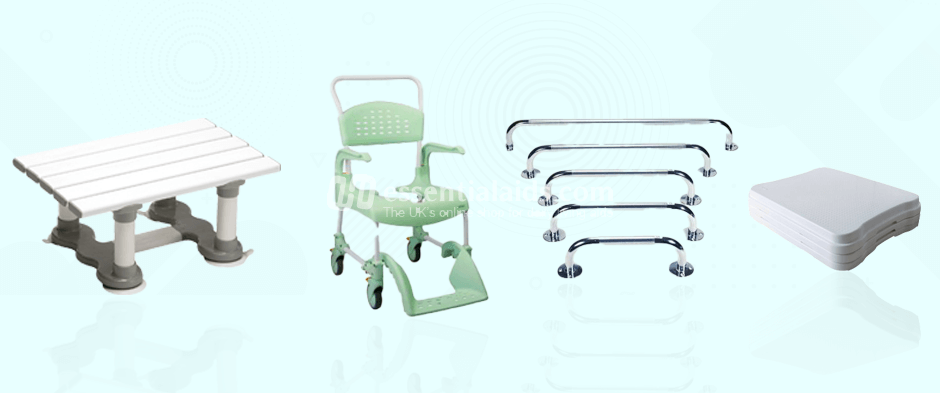
Top 5 Pieces of Equipment to Safely Get In and Out of the Bath
Sally Madeley-Carr, OT10 Jan 2020
The ability to keep yourself clean is one of the basics of maintaining independence in old age. However, many physical conditions associated with growing older bring new challenges in the bathroom.
Enjoying a soak in a hot bath is one of life's great pleasures. But once in the water, many elderly people may have the thought: how am I going to get out again?!
Losing strength, balance or flexibility may make the previously simple process of using the bath more complicated. While some may be lucky enough to have a walk-in shower cubicle and sturdy shower chair, others do not have this option.
Luckily there are practical things you can do to make taking a bath a whole lot easier. Trying some of the wide range of bathing aids available might be a first step. Or you might consider making alterations to the bathroom itself.
Here we'll run through our top five products to help get in and out of the bath.
1. Support Rails
These are among the most straightforward aids to assist balance by providing something to hold on to while climbing in and out of the bath. Rails are available in various lengths, so you should find something to suit your requirement. Most people choose designs complementing their bathroom's décor. Once in place, they are usually unobtrusive.
Some bathroom rails have a smooth gripping surface, while others have ridges or textured patterns. This may make your hands less likely to slip when holding them. This type of rail is great for wet rooms.
While most rails are straight, some have angled designs. There are also support rails which rather than fixing to the wall, clamp to the side of the bath.
Many of this type are like upside-down 'U' rails. The curved section protrudes above the side of the bath, providing a solid point of support when climbing in when pulling oneself out.
Top Tip
Before fixing rails to the wall, use tape to mark out potential positions before enacting the process of getting in and out of a dry bath. Use the tape to indicate exactly where you would like the rails to eventually be, along with the length of rail you might need. Sometimes being in the bath gives you a different perspective than standing by its side.
For wall rails, it is important that they are fitted by a qualified tradesman. They will investigate the surfaces and use the appropriate fixings to make sure the rail can be used safely.
2. Bath Steps
Some people have difficulty lifting their legs over the side of the bath as they attempt to get in. Bath steps provide an effective means of making it easier to climb over the external wall of the bath.
Some types have aluminium legs and are available in various heights. These tend to have rubber or plastic feet, preventing them slipping on tiled surfaces. Others are modular in design and can be stacked to achieve the height required. The component parts lock together, ensuring they don't come apart while in use.
Most bath steps are relatively lightweight and can be moved out of the way when not in use. It is important to remember that steps might not be appropriate for people with impaired balance, especially if a support rail is not within easy reach.
Almost all bath steps have non-slip surfaces where they contact the sole of your feet. This reduces the chance of slipping.
Top Tip
Ensure that you are balanced when using a bath step. These products do not typically fix permanently to the floor, so there is some potential for them to move if you do not take care. Using them in combination with a support rail is a good idea.
3. Bath Seats
Similar to bath steps outside the bath, a bath seat effectively raises the level of the floor inside it. This reduces the user's distance of travel to get in and out. They are much lower than a standard shower chair and have a smaller footprint.
Commonly fitted with suction feet, they are available in various heights. Most have non-slip surfaces for the seat itself.
While most models sit on the floor of the bath, some 'wedge' or 'hang' across it. These push outwards on the walls of the bath to secure the seat, which is suspended above the bath's floor.
It is important to note that this design applies some pressure to the bathtub and is usually only suitable for strong, metal baths.
Suspended versions hang down inside the bath, usually resting on the rim on either side. These can usually be adjusted to fit different sized bathtubs. The part of the frame contacting the edge of the bath will be coated in non-slip material, ensuring it grips effectively. This should also prevent damage to the bath itself.
Many types of suspended bath seats have built-in backrests. This provides a little more security and comfort and also makes them practical shower seats for elderly people as they offer excellent support. Having a backrest means it's difficult to use this type of seat with a bath board, as the back support will usually be higher than the bath's walls.
Top Tip
For freestanding models, make sure you know the dimensions of the available space for the footprint of the bath seat. Their dimensions vary and some bathtubs are too narrow to accommodate them.
4. Bath Boards
A bath board is a classic piece of equipment making it easier to access the bath by providing a solid 'bridge' across it. Available in various widths, you can find one which fits most sizes of bathtub.
They usually secure via outward facing clamps located at either end beneath the sitting surface. These lock in place, creating a stable platform on which to sit. Other more substantial boards may require screwing into the wall.
Some models feature handles which add to safety by providing something to hold on to as you get on and off the board. The sitting surface itself is usually perforated and has a textured surface. This helps water drain and makes it less slippery.
Remember, sitting on a bath board means your body will be above the water with your feet submerged in the water below.
Bath boards can also work as effective shower seats for elderly people. If you have a shower in the bath, you can use the board to sit on for its duration.
Top Tip
Using a bath board along with a bath seat often makes sense. With the board in place, you can lower yourself on to the lower bath seat when getting in and repeating the process in reverse around when getting out. This gives you support and improves safety through the process.
The technique involves first sitting in the middle of the board, with your knees bent and your feet dangling outside the bath. You can swing your legs over the side and into the bathtub.
Now, with your feet in the bath and your hands taking most of your weight on either side, you can lower yourself onto the bath seat below. Once you have finished washing, you can repeat the process in reverse.
It is worth bearing in mind that this requires a fair degree of upper body strength, so may be unsuitable for particularly frail individuals.
5. Leg Lifters
This aid for independence, like all the best inventions, has beauty in its simplicity. It is essentially a nylon strap, one end of which is held in the hand while a loose loop at the other fits around one foot.
When it is pulled upwards, the leg lifts. It is often used as a dressing aid or to help someone get into bed, but it is also fantastically helpful for getting into the bath. It is a practical tool enabling you to lift your bad leg into the bath without fuss.
A leg lifter is ideal for those have lost mobility in one leg, or hip, for example. Even if you simply struggle to bend your knee, this could be an invaluable piece of kit!
Top Tip
This equipment used is highly effective when used in combination with a bath board. Sit on the board and swing your good leg into the bath. Then use the leg lifter to take the weight of your bad leg and swing that over the side of the bath to join the first one.
Other Possibilities
As well as the suggestions above, there are more substantial pieces of equipment you might consider. Some of these require assistance from a carer, so bear that in mind.
Items like bath lifts, bath transfer benches, a swiveling shower chair or inflatable bath cushions are also available and these all assist the process of getting in and out of the bath. We'll deal with these in more details in another blog post. Shower seats for elderly people are also available in various styles - again we will return to the options available in a future post.

Sally Madeley-Carr, OT
Sally qualified as an Occupational Therapist in 1996 and is a well-respected professional in the field of rehabilitation equipment and living aids. She has worked in private practice and within the NHS, developing a broad experience with adults and children. Click here for Sally's registration with the Health and Care Professions Council. The HCPC regulates health, psychological and social work professionals in the UK.